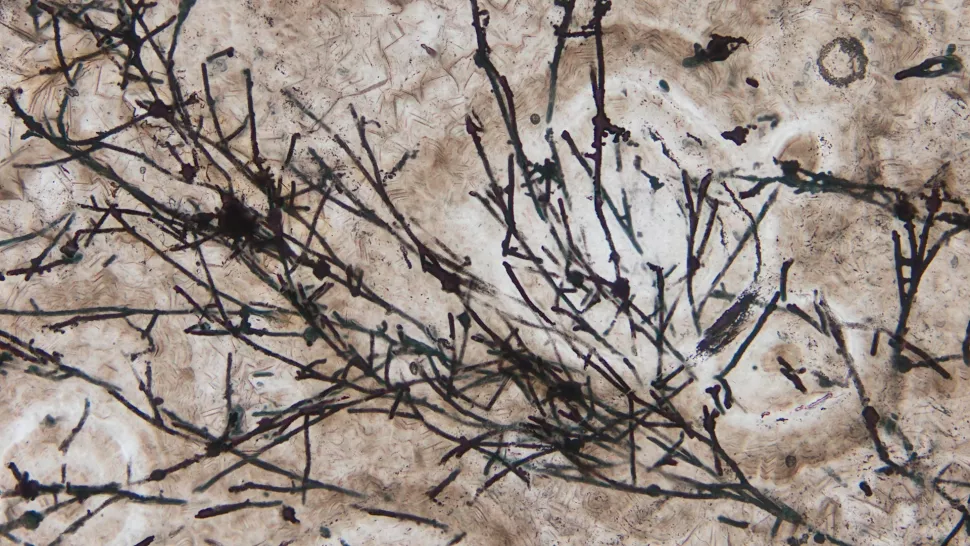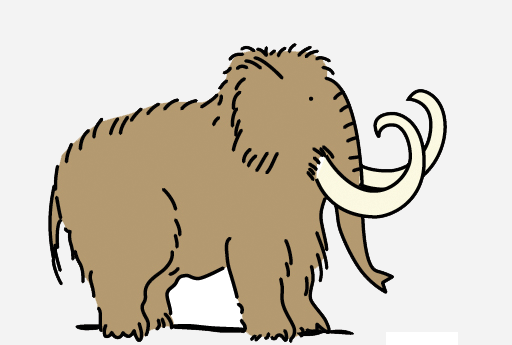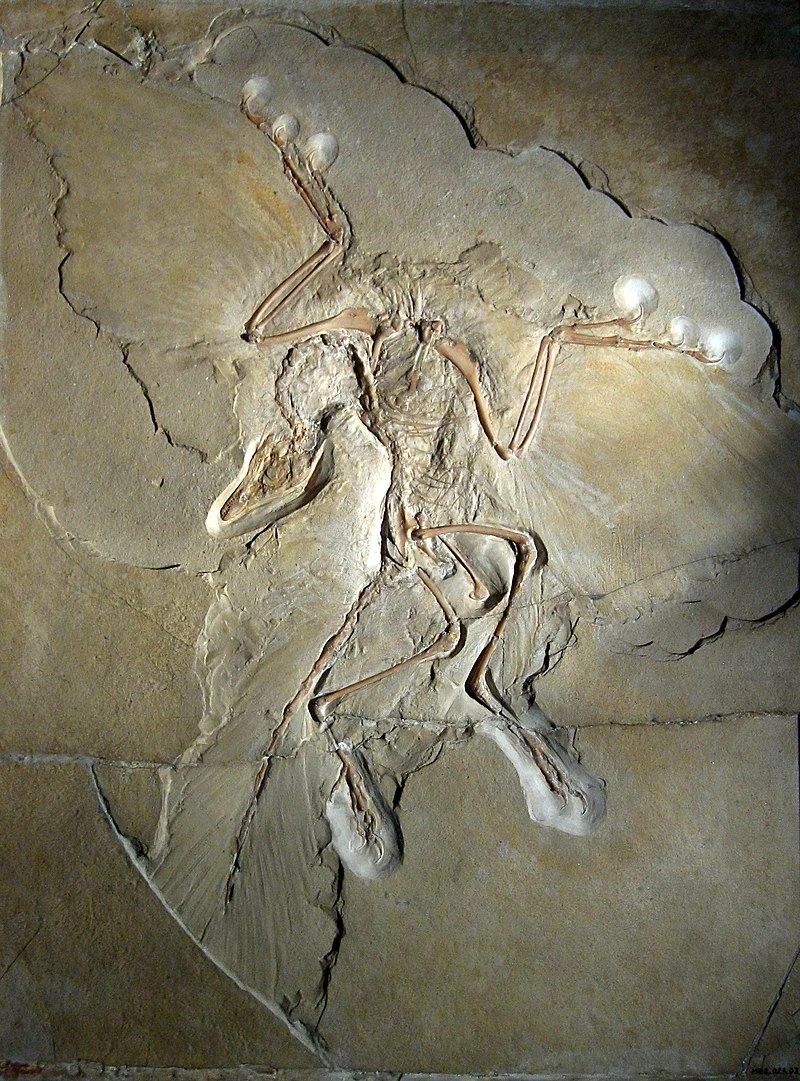Last update: April 2022
Paleogenomics
Chickenosaurus – Story
Dinosaurs haven’t all disappeared? Really?
Context
A mass extinction took place around 66 million years ago, in the spring, caused by the impact of the asteroid ‘Chicxulub impactor’ in Yucatan (Mexico).
This event provoked the disappearance of about 75% of species, including marine molluscs called ammonites and most dinosaurs and marine reptiles.
But not all dinosaurs disappeared: some survived. What have their descendants become?
Here are some pieces of the puzzle, based on small pieces of protein sequences from the fossilized bones of Brachylophosaurus canadensis and Tyrannosaurus rex, two species of dinosaurs which are thought to have disappeared some 80 and 68 million years ago, respectively!
Podcast: C’est au printemps que les dinosaures ont été rayés de la Terre (RTS, mars 2022) (FR) – Source: The Mesozoic terminated in boreal spring (2022)
A collection of fossils
Scientists collect information on the dinosaurs and the species which have disappeared based on different fossils from around the world: this allows them to recover morphological data and even, in some cases, molecular data (DNA or protein) that they can compare to determine the relationship that exists between the different species.
What is a fossil?
Fossils are traces, more or less mineralized, of ancient living organisms: they can be bones, teeth, eggs, traces of their past activity (footprints, coprolite, …) or castings, conserved in sedimentary rock.
And certain fossils still contain DNA or proteins!
Some key dates
Here is a brief summary that recaps the history of life on earth, of dinosaurs…and of the oldest fossils:
Fossilized proteins?
It is nowadays possible to sequence the proteins found in the fossils of eggshells, teeth, bones, or mummified tissues: this field is referred to as ‘Deep Time Paleoproteomics’ …and the records are starting to accumulate as proteins appear to be better preserved than DNA over time and technologies are improving more and more.
Source: Deep Time Paleoproteomics: Looking Forward (2022)
Sequencing a protein?
Like a pearl necklace, a protein consists of a chain of amino acids bound to each other by chemical bonds. There are 20 different amino acids, represented by the letters (G, E, N, I , A, L, …).
Mass spectrometry is a technology which allows proteins to be sequenced, that is, to determine the order of the amino acids in the chain.
Famous proteins in palaeontology…
Collagen and cytochrome are proteins studied by scientists interested in organisms which have disappeared.
Why?
Collagen is one of the most abundant proteins in bones. This protein is the one most frequently found in the organic material present in fossilized bones.
Here is the collagen protein from different species and the collagen protein of species which today have disappeared from the UniProtKB database.
—
The information that we have on certain proteins also comes from DNA. If the DNA sequence is known, the corresponding protein sequence can be predicted. DNA is found primarily in the nucleus of eukaryotic cells, but also in organelles such as mitochondria or chloroplasts. However, the DNA found in the mitochondria is better preserved over time than the DNA present in the nuclei of cells. The cytochrome protein is one of the proteins whose gene is found in mitochondrial DNA.
For example, here is the mitochondrial DNA of Neanderthal man and the sequence of the cytochrome protein of Neanderthal man or, for instance, the sequence of the cytochrome proteins of the dodo bird and of the Tasmanian wolf.
Here is the list of proteins from species which are extinct today from the UniProtKB database.
Here are examples of collagen fragments found for different species.
Tyrannosaurus rex
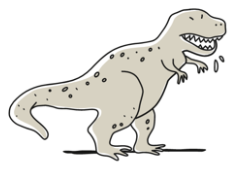
GATGAPGIAGAPGFPGARGAPGPQGPSGAPGPKGSAGPPGATGFPGAAGRGVQGPPGPQGPR
Dating: 68 million years
Gallus gallus (chicken)
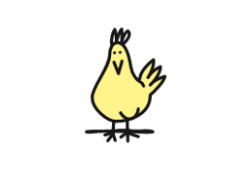
GATGAPGIAGAPGFPGARGPSGPQGPSGAPGPKGNSGEPGAPGNKGDTGAKGEPGPAGVQGP
Dating: 10,000 to 50,000 years
Mammut americanum (mammoth)

GANGAPGIAGAPGFPGARGPAGPQGPSGAPGPKGNSGEPGAPGSKGDAGAGIQGPPGPAGEE
Dating: 1.65 million years
Brachylophosaurus canadensis

GATGAPGIAGAPGFPGARGPSGPQGPSGAPGPKGSAGPPGATGFPGAAGRGETGPAGPAGPP
Dating: 80 million years
The evolution of collagen
To define parentage, biologists search not only for what species have in common, but also for what distinguishes them from one another.
The collagen protein is present, among other places, in the bones of all vertebrates. But as is the case for all proteins, it is a bit different from one species to another. These differences are a real gold mine to study the evolution and the relationship that exists between the different species.
How can one study the relationship between different species?
One can, for instance, count the differences between the collagen sequences from the different species and thus estimate which species are the closest.
The collagen sequences from Brachylophosaurus canadensis and Gallus gallus (chicken) have been aligned below: the presence of an * means that the amino acids are identical.
How many differences are there?

This approach is a bit tedious but, more importantly, it is not quite complete: certain sequence changes have a greater biological impact than others. It’s a bit like a text: some spelling errors will modify the sense of the text while others do not.
This is the reason why bioinformatic programs which compare sequences use ‘substitution matrices’.
A value is attributed to each pair of amino acids (for example: A-A: 4; G-G: 6; A-R: – 1). The sum of these values enables the score of the alignment to be calculated.
For the experts: an example of a substitution matrix
Substitution matrices allow the score of an alignment to be calculated by giving a value to each ‘pair’ of amino acids. Different substitution matrices exist which have been established by studying the evolution of different protein families.
In general, the substitution value is based on the degree of similarity of the two amino acids. If they are very similar (in terms of shape and physicochemical properties), the amino acid pair is probable and will therefore receive a positive score. If the amino acids are very different, the pair is unlikely and will therefore receive a negative score. A score of 0 corresponds to a pair that could be observed by chance.
For example, here is the substitution matrix called BLOSUM62:
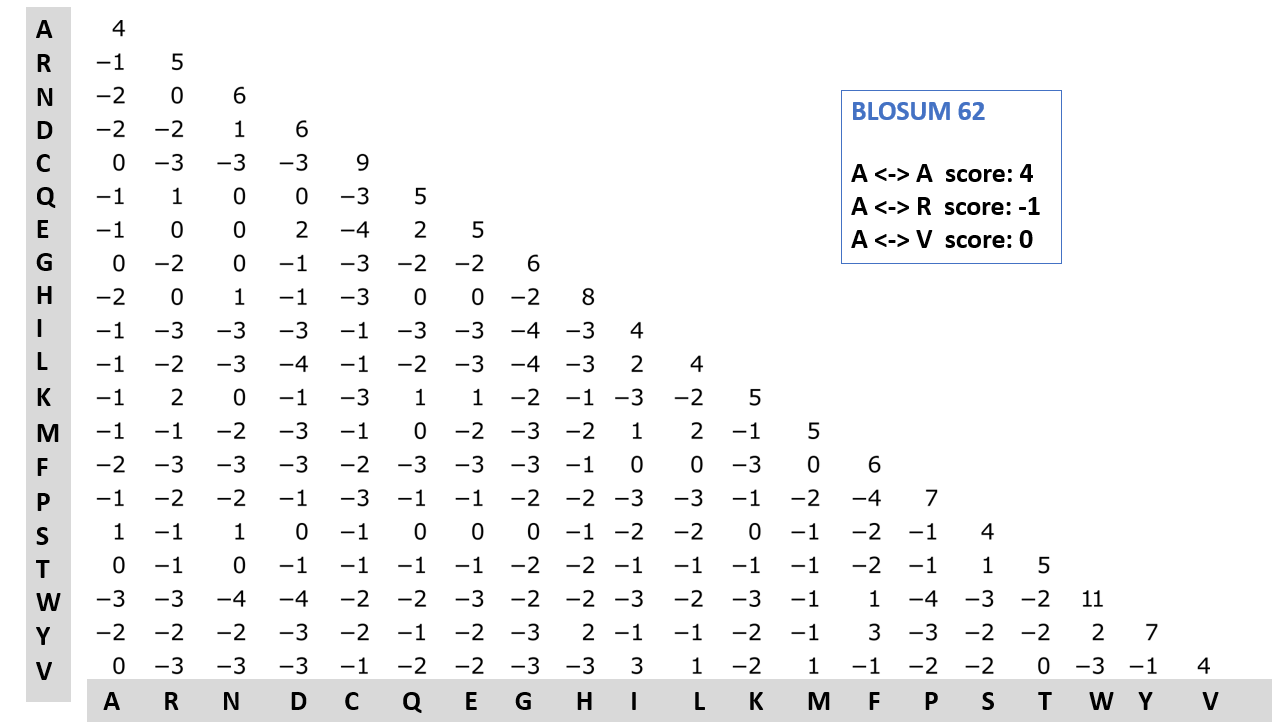
Classification of dinosaurs and birds: an example
The tree below has been calculated by comparing the sequences of different collagen proteins from over 30 different species. It has been validated by complex statistical programs.
Image freely adapted from Expansion for the Brachylophosaurus canadensis Collagen I Sequence and Additional Evidence of the Preservation of Cretaceous Protein (2017)
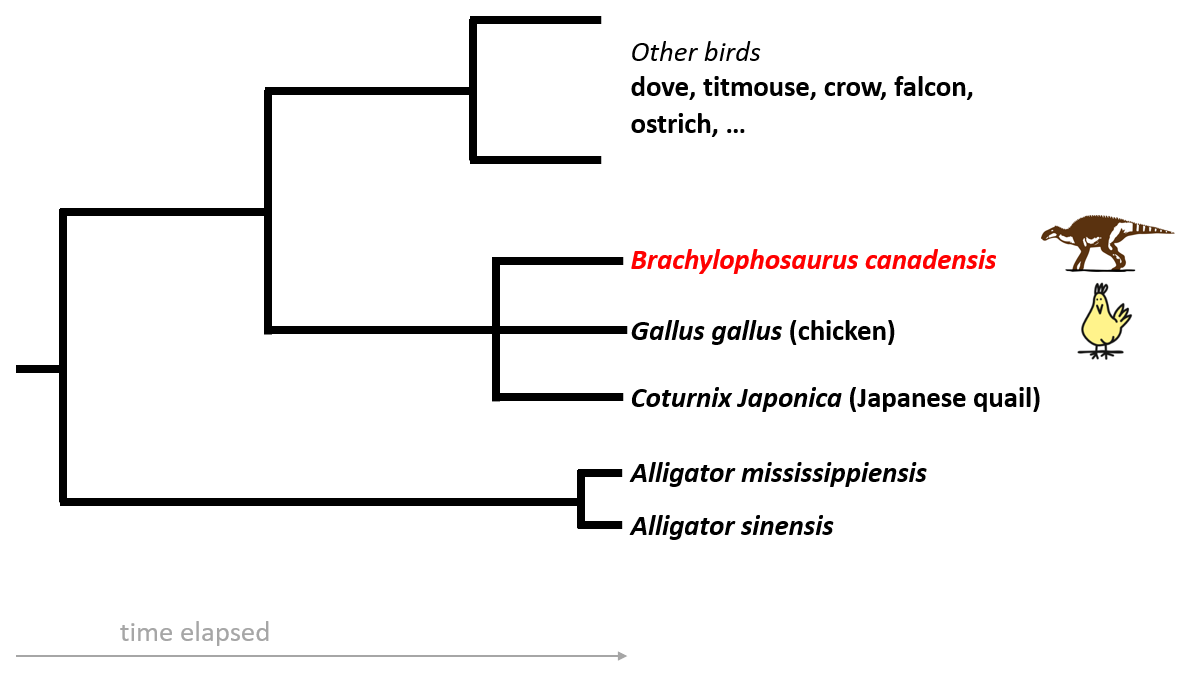
These analyses have made it possible to establish that dinosaurs are closely related to birds.
These results confirm predictions made based on the anatomical comparison of skeletons. However, this is the first molecular (genetic) proof of the evolutionary link that exists between modern birds and dinosaurs.
Dinosaurs have thus not all disappeared: a small group survived and among these, the ‘avian’ dinosaurs, the ancestors of birds.
Another more detailed tree to understand the relationship between birds and dinosaurs (wikimedia).
The mystery of the feather
In 1861, a few months after the publication of Charles Darwin’s work On the Origin of Species, a fossilized feather slightly less than 7 cm in length and about 150 million years old, was discovered in the quarries in Solnhofen, Germany. The identification of the owner of the feather has long been the object of controversy. According to the latest studies, it is thought to have belonged to Archaeopteryx lithographica, a feathered dinosaur.
Source: Detection of lost calamus challenges identity of isolated Archaeopteryx feather (2019)
Today we know that Archaeopteryx lithographica is more related to birds than to other dinosaurs. The classification of dinosaurs and birds, however, still remains controversial!
Some 150 million years ago, Archaeopteryx lithographica belonged to a species among many, a species with no programmed destiny!
Archaeopteryx lithographica Source: Wikipedia

